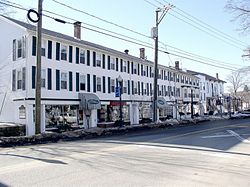United States historic place
| Greenwood Avenue Historic District | |
| U.S. National Register of Historic Places | |
| U.S. Historic district | |
 | |
  | |
| Location | Roughly along Greenwood Ave., P.T. Barnum Sq., Depot Pl., and South St., Bethel, Connecticut |
|---|---|
| Coordinates | 41°22′15.9″N 73°24′45.7″W / 41.371083°N 73.412694°W / 41.371083; -73.412694 |
| Area | 21 acres (8.5 ha) |
| Architectural style | Greek Revival, Italianate |
| NRHP reference No. | 99001568 |
| Added to NRHP | December 17, 1999 |
The Greenwood Avenue Historic District encompasses the historic commercial village center of Bethel, Connecticut. Extending along Greenwood Avenue from P.T. Barnum Square to Depot Place, the district includes a variety of commercial and residential architecture from the mid-19th to early 20th centuries. The district was listed on the National Register of Historic Places in 1999.
Description and history
Bethel began as a parish subdivision (established 1759) of Danbury, and was separately incorporated in 1855. Its early community center was located a short way northeast of Greenwood Avenue, at the site of the present Congregational church. In the early 19th century, the Greenwood Avenue area became home to a number of small hat factories, and commercial development along the avenue began in earnest after the railroad arrived in 1852. The eastern end of the downtown was anchored by the creation in 1881 of P.T. Barnum Square, donated to the town by native son P.T. Barnum.
The historic district includes 29 contributing buildings, 5 non-contributing buildings, and the town green, P. T. Barnum Square. It includes a former railroad station converted into a brewery, and a World War I Doughboy bronze statue sculpted by Ernest Moore Viquesney in P. T. Barnum Square. The oldest building in the district is the Seth Seelye House, built about 1842; it is a fine example of Greek Revival architecture, and now houses the public library. The Bethel Opera House, built as a Greek Revival building about 1848, was given an Italianate restyling, and served as a community gathering space for many years.
See also
References
- ^ "National Register Information System". National Register of Historic Places. National Park Service. March 13, 2009.
- ^ Bruce Clouette and Hoang Tinh (July 20, 1998). "National Register of Historic Places Inventory-Nomination: Greenwood Avenue Historic District". National Park Service. and Accompanying 14 photos, from 1998 (see photo captions pages 15-17 of text document)
| U.S. National Register of Historic Places | |
|---|---|
| Topics | |
| Lists by state |
|
| Lists by insular areas | |
| Lists by associated state | |
| Other areas | |
| Related | |
- Buildings and structures in Bethel, Connecticut
- National Register of Historic Places in Fairfield County, Connecticut
- Italianate architecture in Connecticut
- Greek Revival architecture in Connecticut
- Historic districts in Fairfield County, Connecticut
- Historic districts on the National Register of Historic Places in Connecticut